Apple iPhone 4S: Thoroughly Reviewed
by Anand Lal Shimpi & Brian Klug on October 31, 2011 7:45 PM EST- Posted in
- Smartphones
- Apple
- Mobile
- iPhone
- iPhone 4S
The A5 Architecture & CPU Performance
The original iPhone debuted with a single 412MHz ARM11 core built on a 90nm process. The 3G improved network performance in 2008 but left the SoC untouched. It wasn't until the iPhone 3GS in 2009 that the SoC got a major performance and power update. Apple moved to a 65nm process node, a brand new ARM Cortex A8 based SoC and an upgraded GPU. The A4 released in 2010 once again gave us a process shrink but kept the architecture unchanged.
Apple's A5, first introduced with the iPad 2, keeps process technology the same while introducing a brand new CPU and GPU. The A5 integrates two ARM Cortex A9 cores onto a single die. The improvement over the A4 is tremendous. At the single core level, Apple shortened the integer pipeline without reducing clock speed. With a shorter pipeline the A5 gets more done per clock, and without decreasing clock speed the A5 inherently achieves better performance at the same clock. The move to the Cortex A9 also enables out-of-order instruction execution, further improving architectural efficiency. I've heard there's a 20% increase in performance per clock vs. the Cortex A8, but combine that with the fact that you get two A9s vs a single A8 in last year's design and you get a pretty big performance increase.
There are several situations where the A5's two cores deliver a tangible performance benefit over the A4's single core. Like Android, iOS appears to be pretty well threaded. Individual apps and tasks can take advantage of the second core without a recompile or version update. The most obvious example is web browsing.
Mobile Safari is well threaded. Javascript rendering can be parallelized as well as parts of the HTML parsing/rendering process. All of the major Javascript performance benchmarks show a 60 - 70% increase in performance over the A4, which is partially due to the availability of the second core:
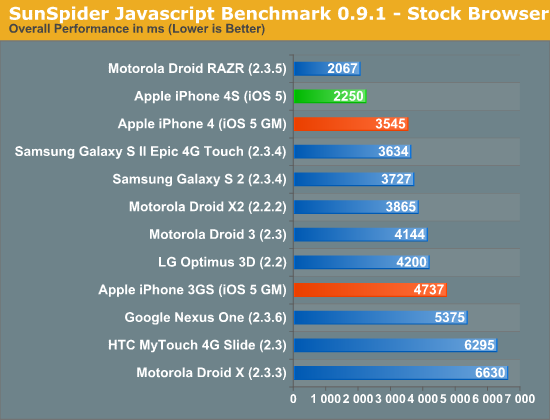
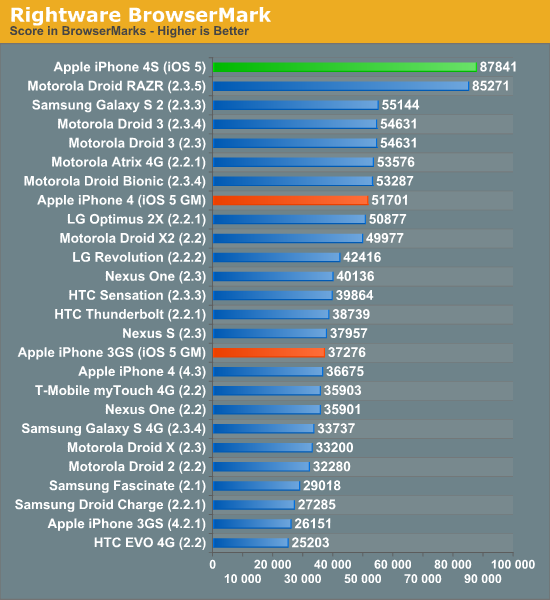
This translates directly into faster page load times. As you can see in the video below, the iPhone 4S (left) loads the AnandTech front page over WiFi in about 5 seconds compared to 9 seconds on the iPhone 4 (right). That's really the best case scenario, the improvement in the next page load time was only about a second (7s vs 8s).
Typical improvements in load time fall in the 10 - 70% range, contributing significantly to the phone feeling snappier than its predecessor. To quantify the improvement I ran through our standard web page loading suite, a test that hits AnandTech, CNN, NYTimes, Engadget, Amazon, Digg and Reddit hosted locally on our lab's network. The average page load time over WiFi for all of the pages is below:
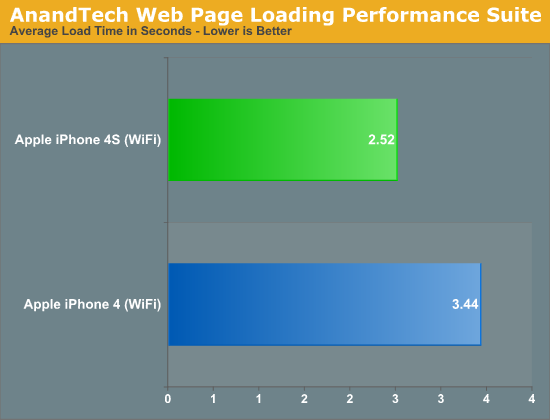
While web page rendering is a natural fit for multiple cores, I was surprised by how poorly threaded some apps ended up being. For example, although I did see performance improvements in exporting edited videos from the iOS version of iMovie, the gains weren't always evident. A quick profile of the app revealed that much of the export process is still single threaded. Just as we've seen on the desktop, there will be some added work necessary to get all apps to utilize multiple cores on iOS.
It's not always performance within an app that saw improvement with the A5: application install and launch times are also much quicker on the 4S. The time to launch Epic's iOS Citadel demo went from 32 seconds on the iPhone 4 to 22 seconds on the 4S. While the iPhone 4 may feel fast enough for many users, the 4S is noticeably faster.
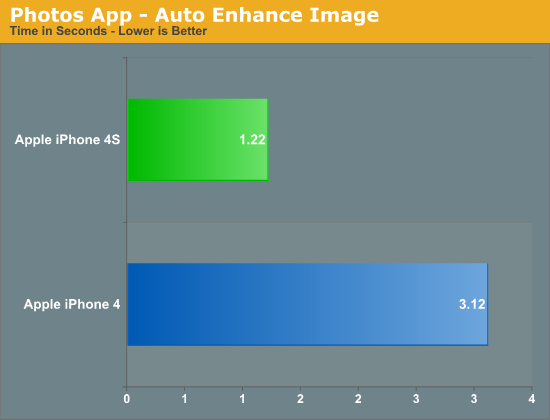
Much of the faster feel comes from by shaving off of seconds here or there. For example, I noticed apps like Messages pop up just slightly quicker on the 4S and you'll see your listing of messages a hair faster than you would on the 4. In the video above you get a brief idea of the sort of subtle improvements I'm talking about. YouTube launches a fraction of a second quicker on the 4S vs the 4.
These subtle decreases in response time are simply icing on the cake. The move from a 4 to a 4S is one of those upgrades that you'll notice right off the bat but will really appreciate if you go back to an iPhone 4 and try to use it. If you do a lot of web browsing on your phone, you'll appreciate the 4S.
I wasn't entirely sure whether or not I could attribute all of these performance improvements to the faster CPU. It's possible that some of the tests I mentioned are IO bound and Apple could have used faster NAND in the 4S. To find out I rounded up a bunch of iPhone 4Ses at all available capacities and measured sequential write speed:
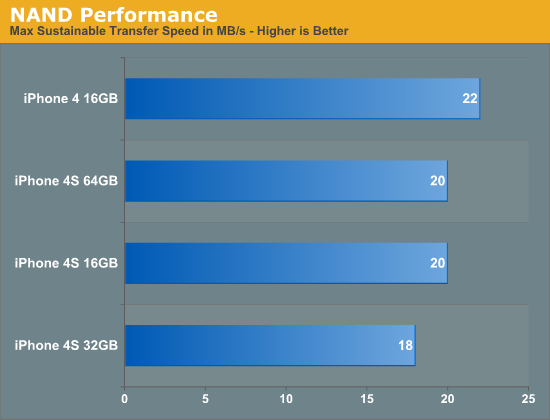
Apple uses multiple sources for NAND so it's possible that you'll see these numbers move around a bit depending on your particular phone. It looks like the iPhone 4S' NAND is no faster than what Apple shipped last year - at least in sequential write speed. The target appears to be 20MB/s and Apple does its best to stay around there. My iPhone 4 is actually pretty quick at 22MB/s but the advantage isn't significant enough to make a huge deal about. I don't have a good way of measuring random IO performance yet but application launch time is largely governed by sequential IO so I don't expect we're seeing gains from anything outside of the CPU and memory bandwidth in the earlier tests.


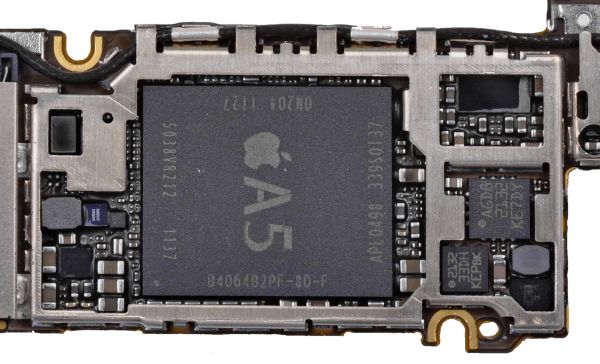








199 Comments
View All Comments
thunng8 - Thursday, November 3, 2011 - link
You do realize that the top 3 results are all vsync limited? They are all close to 60fps. That makes it not a great test to show the full potential of the gpu.ReverendDC - Friday, November 4, 2011 - link
I was wondering why there were no WPs in your comparison. They have comparable screens, functionality, and features.This is NOT to start a flame war. I am curious about how some of the newer WPs especially line up (Titan, Lumina 800, Focus S, etc).
Thanks!
mymomentummedia - Sunday, November 6, 2011 - link
Here is a 360 degreee review of the iPhone 4s with a beautiful girl in a swimsuit... no complaints here.http://www.youtube.com/watch?v=-eNxXBIV9_s
yeatzeck - Sunday, November 6, 2011 - link
According to the Chipworks (http://www.chipworks.com/en/technical-competitive-... in iPhone 4S is Sony's camera (they even X-ray it).You probably have to update the review.
mosmov - Monday, November 7, 2011 - link
You've run the Taiji for many devices so far.I'd like to see the number also for 4S to align the result with other devices in my memory.
tipoo - Monday, January 2, 2012 - link
Taiji is for Android...Conficio - Monday, November 7, 2011 - link
Here is the viral tip for Apple (or its competitors). Make it an option to deliver the text as well as the ability for the recipient to actually listen to the voice command recorded (sans the edit commands, etc.) That will become fast the fastest way to leave voice messages, because you don't have to wait for the phone to dial, time out and get through the voice mail instructions.
HelloChris - Monday, November 7, 2011 - link
Long time reader, but something in this review made me register a username so I could add to the comments...Anand's webpage-refreshing battery life test saw the iPhone 4S achieve around 10 and 11 hours, for 3G and WiFi, respectively. However, MANY new 4S owners (including myself) have been getting battery life which is roughly half of that. I just finished reading this whole review, and I have to wonder if the test unit sent to Anandtech might have been hand-picked by Apple? 10/11 hours is just so much more than everyone else seems to be getting. I've averaged 6.5 hours of total usage, and this includes several hours of use where I'm using absolutely no 3G/WiFi data, and minimal processing power (example: viewing a PDF, viewing pictures, reading items on my Google Reader feed)...
If you look on the major apple forums there are multiple threads where there are many users experiencing the same conditions.
Also, I'm aware of the battery issue with iOS 5 (which Apple acknowledged last week and has a beta update out already for) which implies that this is indeed a software, not a hardware issue.
Perhaps I'm missing something, but if it's the case that AnandTech received a well-performing test unit, that would explain their extraordinary battery life.
doobydoo - Friday, December 2, 2011 - link
I think you answer your own question.It sounds like your phone is affected by the battery life issue for which a software patch has been released, wheras Anand's probably wasn't.
The vast majority of iPhone 4S owners didn't experience any issues with battery life.
medi01 - Tuesday, November 8, 2011 - link
To care about "improved vibration" I have first to be somehow concerned with current "unimproved" vibration. Which I don't. And I don't know any person that is.